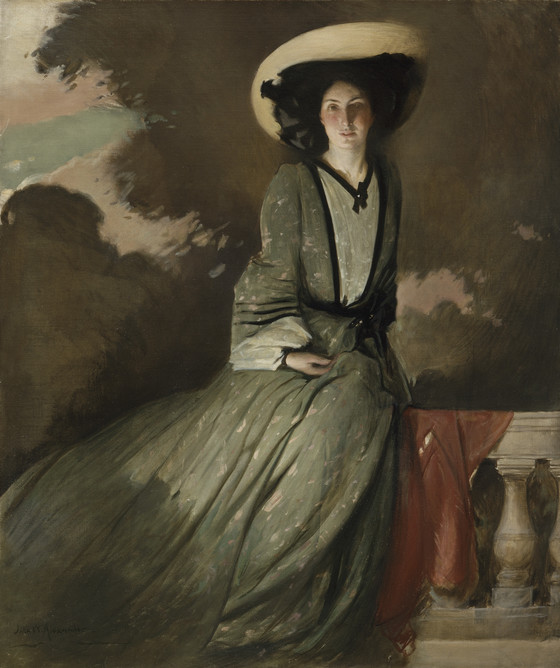Elizabeth Alexander (1867-1947) was the daughter of James W. Alexander, who was introduced to John White Alexander by Joseph Harper because of the similarity of their names....
Elizabeth Alexander (1867-1947) was the daughter of James W. Alexander, who was introduced to John White Alexander by Joseph Harper because of the similarity of their names. Elizabeth and John were married in 1887, and the following year their only child, James, was born. Elizabeth was an educated, attractive woman who enjoyed the company of her husband’s circle of painters and writers.
This portrait of her was painted in Alexander’s New York studio late in 1902 and immediately included in his exhibition at Durand-Ruel’s galleries held in late November. It was one of the favorites of the exhibition, commended for its subdued color, flowing line, and grace. The portrait demonstrates Alexander’s mature style as it developed from his symbolist days in Paris. It is an evocative figure study in which mood and atmosphere take precedence over frank likeness. The portrait was painted in a palette of muted pinks and moss green -- the artist’s favorite colors -- on a coarse, loosely woven, absorbent canvas to produce a soft, hazy effect. Alexander cast his wife in a somewhat ambiguous, shadowy outdoor setting with dramatic spotlighting on her face and right hand. The strong light shining from below, which first appeared in Alexander’s early theatrical portraits of the 1880s, reappeared in his paintings of the late 1890s. Such lighting seems quite appropriate for a portrait of Elizabeth Alexander, for she not only shared her husband’s interest in the theater, she also collaborated closely with him on costume and lighting designs and, after his death , made a distinguished career in the theatrical arts. The shadowy illumination heightens the quiet sense of mystery which pervades the best of Alexander’s mature figure paintings.
Despite her quite independent nature -- in the 1910s she became active in the women’s suffrage movement -- Mrs. Alexander was portrayed by her husband as a fragile beauty. Her billowing gown forms a gentle flowing line, echoing the curves of her hat and the shadowy trees and clouds in the background. Alexander was deeply interested in late nineteenth-century theories regarding the psychology of line, and in the 1890s he began to compose paintings of elegant women in terms of sensuous, curving shapes. His fascination with emotive line caused Alexander to become increasingly bold, and by the early twentieth century he was creating paintings in which the figures and their dresses form daringly abstract compositions of exaggerated line and flat patterns.
Elizabeth Alexander often posed for her husband; between 1893 and 1902 he painted at least five portraits of her. This is one of the largest compositions identified as her portrait. Its size, as well as the full length of the figure and the presence of a balustrade -- a traditional motif of eighteenth-century portraits set in gardens -- places the painting within the grandmanner portrait tradition. When the painting was first publicly displayed, critics commented on its English landscape setting and Mrs. Alexander’s old fashioned gown, noting that it recalled the work of Thomas Gainsborough (1727-1788).
After the artist’s death the portrait was included in numerous memorial exhibitions, usually with the title On a Balcony. By 1939 when it was included in an exhibition at the Art Institute of Chicago, the painting had become confused with another full-length portrait of Mrs. Alexander, one dated 1894 and sometimes referred to as Changeable Taffeta (estate of the artist as of 1985). Consequently much of the subsequent literature on Alexander has included a date much too early for this painting and also incorrect exhibition and literature documentation.
More...



